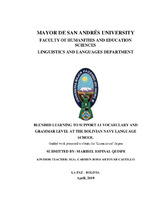Mostrar el registro sencillo del ítem
Blended learning to support a1 vocabulary and grammar level at the Bolivian Navy Language School
| dc.contributor.author | Espinal Quispe, Maribel | |
| dc.contributor.author | Artovar Castillo, Carmen Rosa (Tutora) | |
| dc.date.accessioned | 2019-07-03T21:19:58Z | |
| dc.date.available | 2019-07-03T21:19:58Z | |
| dc.date.issued | 2019-04 | |
| dc.identifier.citation | Tesis de Grado | es_ES |
| dc.identifier.uri | http://repositorio.umsa.bo/xmlui/handle/123456789/21705 | |
| dc.description.abstract | The following proposal consists of a six-month process of a guided work carried out at the Bolivian Navy Language School; it also refers to the results found in this process of blended learning to support A1 vocabulary and grammar level at the Bolivian Navy Language School based on a needs analysis. In doing so, this guided work was aimed at consolidating language knowledge in students’ English program at Bolivian Navy Language School. The project proposes an innovative elaboration of supplementary material aligned with the Common European Framework in a blended learning environment by means of the development of interactive activities to support A1 students’ process vocabulary and grammar language learning as part of this new educational generation. Besides, describing the instructional teaching material used at the Bolivian Navy Language School, there were some considerations to take into account; it is based on the natural approach, it dates from 1990s and it is developed by Defense Language Institute English Language Center from Texas. As the instructional teaching material is out of date, the instructors of Bolivian Navy Language School guided the instructional material in a communicative approach at the time to teach the English language. In the development of the project, the enrolled participants were those students who were in the basic higher-level course of Bolivian Navy Language School. In this case, the educative software selected to develop the activity exercises was Ardora and the total number of activities developed were 542 that considered the 12 books, and 48 lesson of the A1 Level according to Common European Framework of Languages. All the activities had their own self-evaluation and the scores changed according to the lesson in this case the higher score was 122 point, the medium score was 90 points and the lower score was 65 points. All the material was assessed in a pre and post-test evaluation in order to compare the progress students achieved in the development of the language learning process. Moreover, two different questionnaires applied multiple choice and open-ended question at the begging and at the end of each evaluation to consider and take account of the opinions and observations that the participants had at the time to develop the activity exercises. Hence, the process of the guided work and the results obtained consider six chapters. The first chapter comprises the institution background, context description, the institution language program and identified needs. The second chapter presents the theoretical framework. The third chapter presents the project proposal´s objectives, achievement categories, action strategies and the project work plan. The fourth chapter presents the proposal development, sequence of activities, initial achievements and experiences. The fifth chapter explains the project outcomes. Finally, the sixth chapter shows the conclusions and recommendation of this study. | es_ES |
| dc.language.iso | en | es_ES |
| dc.subject | GRAMÁTICA INGLES | es_ES |
| dc.subject | IDIOMA INGLES APRENDIZAJE | es_ES |
| dc.title | Blended learning to support a1 vocabulary and grammar level at the Bolivian Navy Language School | es_ES |
| dc.type | Thesis | es_ES |

